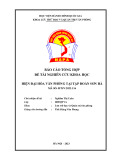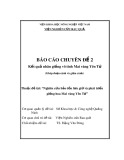
Page 1 of 2
(page number not for citation purposes)
Available online http://ccforum.com/content/11/5/168
Abstract
Mechanotransduction holds the underlying mechanisms of ventilator-
induced lung injury. Research on this subject, however, could be
difficult for clinicians, especially when results are controversial. A
recent study by Li and co-workers is used as an example, to explain
how to critically read literatures related to basic science and how to
understand the limitation of experimental studies.
As a professor in a clinical department, I am privileged to
work with many clinician-investigator trainees. Recently, a
new clinical research fellow told me that he had been reading
many papers in order to decide which research project he
should take. The more he reads, the more confused he feels.
Many literatures sound contradictory. How to determine their
clinical relevance is a challenge. In fact, this challenge is not
only to new fellows, but also to experienced researchers.
In this issue of Critical Care, Dr Li and Dr Quinn and their
colleagues published a research article [1] exploring the
molecular mechanisms of ventilator-induced lung injury (VILI).
I would like to use this interesting article as an example, to
lead readers who are not experts in this field through a
translational process.
Mechanical force-induced signal transduction (mechano-
transduction) is responsible for many physiological processes
in lung development [2], in maintaining lung functions [3], and
in pathological conditions related to lung diseases, such as
asthma, chronic obstructive pulmonary disease (COPD), and
acute respiratory distress syndrome (ARDS), especially
related to VILI [4]. However, very much like the routes in a
city, both “good boys” and “bad boys” drive on the same
streets. Many signal transduction pathways are shared by
both the injury and repair processes.
Neutrophil recruitment and activation is an important
mechanism for lung tissue injury, which is mediated by a
group of small molecules, namely chemokines, especially a
subgroup of C-X-C chemokines. Interleukin-8 (IL-8) is the
best example, which has been shown to be up-regulated by
mechanical forces in human lung cells [5]. Rodents do not
have the IL-8 gene, but produce macrophage inflammatory
protein-2 (MIP-2) and other C-X-C chemokines. Mechanical
stretch induced MIP-2 in rat lung cells [6]. Increased MIP-2 in
murine lung was observed after high volume ventilation by Dr
Li and co-workers [7]. They further questioned that neutrophil
migration is mediated by a signal pathway activated by Akt
(also called protein kinase B). They used Akt+/- mice, which
have lower expression of Akt-1. They also used a chemical
inhibitor to prevent the activation of Akt in mice, prior to their
exposure to high volume ventilation and/or hyperoxia. Indeed,
they demonstrated less lung damage in these experimental
settings. This is very exciting, isn’t it? However, it is worth
mentioning that the Akt pathway is also critically important for
proliferation, survival and migration of cell types other than
neutrophiles [8]. Inhibition of this pathway in sepsis related
lung injury is detrimental [9,10]. The clinical application of this
strategy needs to be cautious.
Well, another interesting target is nitric oxide (NO). Based on
their recent studies, these researchers suspected that
endothelial nitric oxide synthase (eNOS) activation is also part
of the mechanisms responsible for VILI. They demonstrated
increased phosphorylation of eNOS and also demonstrated
that nitric oxide synthase (NOS) inhibitor could attenuate VILI.
Increased NOS expression and/or activity have been shown in
multiple lung injury models [11] and clinical samples [12]. The
outcome of NO related clinical studies, however, is
controversial [13], which warns us for further investigation.
Commentary
Ventilator-induced lung injury and mechanotransduction:
why should we care?
Mingyao Liu1
1Department of Surgery, Faculty of Medicine, University of Toronto, Toronto, Ontario, Canada
Corresponding author: Mingyao Liu, mingyao.liu@utoronto.ca
Published: 26 October 2007 Critical Care 2007, 11:168 (doi:10.1186/cc6131)
This article is online at http://ccforum.com/content/11/5/168
© 2007 BioMed Central Ltd
See related research by Li et al, http://ccforum.com/content/11/5/R89
ARDS = acute respiratory distress syndrome; COPD = chronic obstructive pulmonary disease; eNOS = endothelial nitric oxide synthase; IL-8 =
Interleukin-8; MIP-2 = macrophage inflammatory protein-2; NO = nitric oxide; NOS = nitric oxide synthase; VILI = ventilator-induced lung injury.

Page 2 of 2
(page number not for citation purposes)
Critical Care Vol 11 No 5 Liu
As a clinician you may ask why 30 ml/kg of tidal volume was
used in this study and you may note that oxygen was used
for ventilation. These injurious regimens have been less (if at
all) used clinically. Are these experimental data really useful?
This is really a good question. First of all, as experimental
biologists, we always try to create a condition that can give
definite answers. For example, after serum starvation, add a
growth factor into the culture medium to initiate a signal
transduction, or start mechanical stretch on statically
cultured cells. These protocols help us to reveal the potential
of a biological stimulus on a particular biological process.
This strategy has also been adapted to animal studies. On
the other hand, this may also explain why many experimental
findings did not translate to good clinical practices. As a
bench scientist, one should try to simulate clinical conditions
as much as possible. Recently, clinically relevant models
have been emphasized [14].
After going through this interesting paper critically, what have
we learnt? First, good literature review may lead to proposal
of a testable hypothesis in VILI. Secondly, the mechanical
force-induced signal transduction by injurious ventilation
(high tidal volume and high oxygen tension) could activate
pathways that are important for normal functions. Thirdly,
blocking the transient activation of these pathways could be
beneficial. Last but not the least, awareness of the
significance and limitation of experimental data are crucial for
our knowledge translation.
Competing interests
The authors have no competing interests.
References
1. Li L-F, Liao S-K, Lee C-H, Huang C-C, Quinn DA: Involvement of
Akt and endothelial nitric oxide synthase in ventilation-
induced neutrophil infiltration: a prospective, controlled
animal experiment. Crit Care 2007, 11:R89.
2. Liu M, Post M: Invited review: mechanochemical signal trans-
duction in the fetal lung. J Appl Physiol 2000, 89:2078-2084.
3. Liu M, Tanswell AK, Post M: Mechanical force-induced signal
transduction in lung cells. Am J Physiol 1999, 277:L667-683.
4. Han B, Lodyga M, Liu M: Ventilator-induced lung injury: role of
protein-protein interaction in mechanosensation. Proc Am
Thorac Soc 2005, 2:181-187.
5. Li LF, Ouyang B, Choukroun G, Matyal R, Mascarenhas M, Jafari
B, Bonventre JV, Force T, Quinn DA: Stretch-induced IL-8
depends on c-Jun NH2-terminal and nuclear factor-kappaB-
inducing kinases. Am J Physiol Lung Cell Mol Physiol 2003,
285:L464-475.
6. Mourgeon E, Isowa N, Keshavjee S, Zhang X, Slutsky AS, Liu M:
Mechanical stretch stimulates macrophage inflammatory
protein-2 secretion from fetal rat lung cells. Am J Physiol Lung
Cell Mol Physiol 2000, 279:L699-706.
7. Quinn DA, Moufarrej RK, Volokhov A, Hales CA: Interactions of
lung stretch, hyperoxia, and MIP-2 production in ventilator-
induced lung injury. J Appl Physiol 2002, 93:517-525.
8. Luo J, Manning BD, Cantley LC: Targeting the PI3K-Akt
pathway in human cancer: rationale and promise. Cancer Cell
2003, 4:257-262.
9. Williams DL, Li C, Ha T, Ozment-Skelton T, Kalbfleisch JH,
Preiszner J, Brooks L, Breuel K, Schweitzer JB: Modulation of the
phosphoinositide 3-kinase pathway alters innate resistance
to polymicrobial sepsis. J Immunol 2004, 172:449-456.
10. Wrann CD, Tabriz NA, Barkhausen T, Klos A, van Griensven M,
Pape HC, Kendoff DO, Guo R, Ward PA, Krettek C et al.: The
phosphatidylinositol 3-kinase signaling pathway exerts pro-
tective effects during sepsis by controlling C5a-mediated acti-
vation of innate immune functions. J Immunol 2007, 178:
5940-5948.
11. Liu M, Tremblay L, Cassivi SD, Bai XH, Mourgeon E, Pierre AF,
Slutsky AS, Post M, Keshavjee S: Alterations of nitric oxide syn-
thase expression and activity during rat lung transplantation.
Am J Physiol Lung Cell Mol Physiol 2000, 278:L1071-1081.
12. Cardella JA, Keshavjee SH, Bai XH, Yeoh JS, Granton JT, Meade
MO, Matte-Martyn A, Waddell TK, Liu M: Increased expression
of nitric oxide synthase in human lung transplants after nitric
oxide inhalation. Transplantation 2004, 77:886-890.
13. Ichinose F, Roberts JD, Jr., Zapol WM: Inhaled nitric oxide: a
selective pulmonary vasodilator: current uses and therapeutic
potential. Circulation 2004, 109:3106-3111.
14. Steinberg J, Halter J, Schiller H, Gatto L, Nieman G: The devel-
opment of acute respiratory distress syndrome after gut
ischemia/reperfusion injury followed by fecal peritonitis in
pigs: a clinically relevant model. Shock 2005, 23:129-137.




![PET/CT trong ung thư phổi: Báo cáo [Năm]](https://cdn.tailieu.vn/images/document/thumbnail/2024/20240705/sanhobien01/135x160/8121720150427.jpg)





















